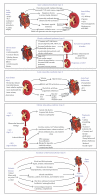Cardiorenal syndromes: pathophysiology to prevention
- PMID: 21151537
- PMCID: PMC2995900
- DOI: 10.4061/2011/762590
Cardiorenal syndromes: pathophysiology to prevention
Abstract
There is a strong association between both acute and chronic dysfunction of the heart and kidneys with respect to morbidity and mortality. The complex interrelationships of longitudinal changes in both organ systems have been difficult to describe and fully understand due to a lack of categorization of the common clinical scenarios where these phenomena are encountered. Thus, cardiorenal syndromes (CRSs) have been subdivided into five syndromes which represent clinical vignettes in which both the heart and the kidney are involved in bidirectional injury and dysfunction via a final common pathway of cell-to-cell death and accelerated apoptosis mediated by oxidative stress. Types 1 and 2 involve acute and chronic cardiovascular disease (CVD) scenarios leading to acute kidney injury (AKI) or accelerated chronic kidney disease (CKD). Types 3 and 4 describe AKI and CKD, respectively, leading primarily to heart failure, although it is possible that acute coronary syndromes, stroke, and arrhythmias could be CVD outcomes in these forms of CRS. Finally, CRSs type 5 describe a systemic insult to both heart and the kidneys, such as sepsis, where both organs are injured simultaneously in persons with previously normal heart and kidney function at baseline. Both blood and urine biomarkers, including the assessment of catalytic iron, a critical element to the generation of oxygen-free radicals and oxidative stress, are reviewed in this paper.
Figures
References
-
- McCullough PA. Why is chronic kidney disease the “spoiler” for cardiovascular outcomes? Journal of the American College of Cardiology. 2003;41(5):725–728. - PubMed
-
- Sarnak MJ, Levey AS, Schoolwerth AC, et al. Kidney disease as a risk factor for development of cardiovascular disease: a statement from the American Heart Association Councils on Kidney in Cardiovascular Disease, High Blood Pressure Research, Clinical Cardiology, and Epidemiology and Prevention. Circulation. 2003;108(17):2154–2169. - PubMed
-
- Shah SV. Oxidants and iron in chronic kidney disease. Kidney International, Supplement. 2004;66(91):S50–S55. - PubMed
-
- Walker BL, Tiong JWC, Jefferies WA. Iron metabolism in mammalian cells. International Review of Cytology. 2001;211:241–278. - PubMed
LinkOut - more resources
Full Text Sources
Other Literature Sources


